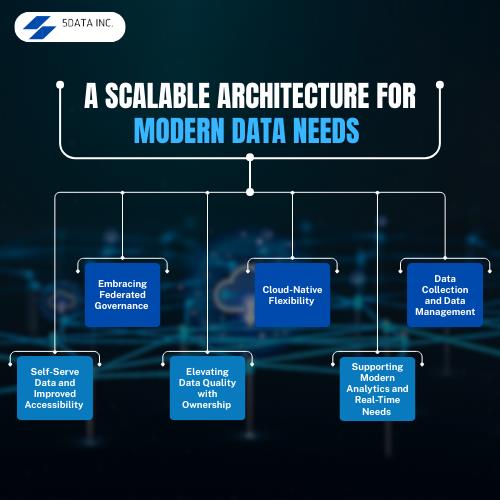Now, rather than being forced to carve their organization into ever tighter monolithic structures, enterprises can adopt a more organic, fluid approach that auto-synchronizes their efforts onto a single data system.
Key Takeaways
- Data mesh transfers control of data from centralized teams to domain-specific units, leading to faster decision-making and scalable architecture.
- By allowing teams that generate and use data to take ownership, organizations enhance data quality, ensure accountability, and promote collaboration.
- Data mesh also fosters federated governance, enabling domain teams to follow enterprise standards while managing their own data, thus improving compliance, accessibility, and real-time insights without losing control.
The Rise of Data Mesh
Coined by Zhamak Dehghani, the concept of data mesh was born out of frustration with the limits of centralized data lakes and warehouses. Despite technological advancements in cloud architecture and data platforms, many enterprises continued to face bottlenecks in data delivery, data quality, and usability.
Data mesh flips the traditional approach by treating data as a product and organizing teams around domain ownership. Instead of one central team handling all data, each business unit manages its own data as a product, complete with dedicated owners, SLAs, and documentation.
Moving Away from Centralized Data Architecture
Data architecture that utilizes a centralized approach requires the existence of a principal group or individual in charge of data collection, maintenance, and dissemination. Relying on a single individual results in a data bottleneck and decreases scalability. Backlogs often plague engineering teams, resulting in disconnected data pipelines.
The theory put forward by data mesh entirely focuses on how data is controlled and managed rather than what the data itself shows. This gives organizations a complete bonanza, as decentralized data units such as marketing or finance are unchained and can now administer and serve their data independently. Domain data experts are free from depending on data engineers lower in the organizational hierarchy. This assists the central units while also greatly accelerating the company’s efficiency.
A Scalable Architecture for Modern Data Needs
Scalability is not a buzzword but a necessity. With businesses generating tremendous amounts of real-time data, systems must be able to scale horizontally and vertically. Data mesh guarantees a scalable architecture to manage higher workloads and varied data sources.
By distributing the load of data products between domains, organizations are able to grow their analytics architecture without hitting performance walls. Each team is a node in a network that produces and consumes data with low dependency and latency.
Self-Serve Data and Improved Accessibility
One key principle of data mesh is self-serve data infrastructure. This means creating easy-to-use platforms where data producers and consumers can discover, access, and use data without needing to go through a centralized bottleneck.
Think of it as an internal data marketplace—teams publish high-quality data products that others can browse and utilize. This approach significantly boosts productivity and reduces time to insight.
Embracing Federated Governance
With decentralization comes the need for robust data governance. However, rather than enforcing rigid rules from a central authority, data mesh promotes federated governance. This model allows domain teams to establish local policies aligned with enterprise-wide standards.
Metadata management, access control, and data lineage become shared responsibilities. As a result, governance becomes embedded in the daily workflows of domain teams instead of being a separate compliance exercise.
Elevating Data Quality with Ownership
The instant teams own their own data products, there is an automatic increase in data quality. When individuals realize they are the custodians of a dataset, they will be more inclined to make it accurate, timely, and usable.
This is one of the primary benefits of domain ownership. With those most intimately familiar with the data also responsible for its maintenance, problems are addressed quicker, and datasets are up-to-date and clean.

Cloud-Native Flexibility
Modern businesses live in the cloud. A successful data mesh architecture integrates seamlessly with cloud architecture, making it easy to adopt best-of-breed tools and services. Whether you’re using AWS, Azure, or Google Cloud, a data mesh model allows you to orchestrate data pipelines, manage workloads, and enforce governance without compromising on flexibility.
This adaptability also benefits those seeking Data Life Cycle Management Services tailored to specific cloud ecosystems and domain requirements.
Supporting Modern Analytics and Real-Time Needs
Today’s users don’t just want data—they want insights. Data mesh makes it possible to deliver real-time data to analysts, dashboards, and applications by streamlining analytics infrastructure and eliminating centralized processing delays. For industries like finance or e-commerce, where milliseconds matter, this ability to react to data as it flows is a game changer.
Data Collection and Data Management
The evolution toward decentralized, product-oriented data systems has also influenced the landscape of external vendors. Now, Data Collection And Data Management Service Providers must align their offerings with mesh-friendly solutions, ensuring that their tools support domain-driven development, open APIs, and scalable ingestion pipelines.
These shifts are pushing the market to deliver more agile, composable tools that work within the mesh model rather than against it. Moving to data mesh is not all about tools—it’s about culture. It demands leadership buy-in, investment in training, and a reimagination of how teams engage with data.
By redefining roles and responsibilities, businesses can foster cooperation between departments, allowing for a unified modern architecture that brings people, processes, and platforms together.
Metadata Management
Metadata management has never been more essential in a mesh environment. From data lineage tracking to usage pattern management and compliance enforcement, metadata forms the basis of trust and usability. Automated metadata capture, labeling, and categorization enable teams to create intuitive data catalogs that drive discovery and self-service.
Recognizing this need for agility and performance, many tech firms now integrate mobile application development services with their data solutions—empowering businesses to deliver smarter, data-driven apps faster and more efficiently.
Conclusion
The transition to data mesh marks the beginning of a broader shift in data management. Moving away from single, monolithic solutions supported by siloed organizations, modern data platforms are becoming adaptive, domain-driven, and collaborative. As more companies embrace this model, we can anticipate rapid innovation across tooling, governance, and user enablement. It’s not just a technical revolution—it’s a strategic one.
FAQs
Q: What is a data mesh and how does it differ from traditional data architecture?
A data mesh is a decentralized approach to data architecture that treats data as a product and gives domain teams ownership. Unlike centralized models, it promotes scalability, agility, and better data quality.
Q: Why is domain ownership important in data mesh?
Domain ownership ensures that the teams closest to the data are responsible for its quality, security, and usability, leading to faster problem resolution and more reliable datasets.
Q: How does data mesh support data governance?
Data mesh uses a federated governance model in which each domain team adheres to centralized standards while managing its data locally, striking a balance between control and flexibility.
Q: What industries benefit the most from data mesh architecture?
Industries with large, distributed datasets—such as finance, healthcare, retail, and technology—see the most benefits from data mesh due to its scalability and ability to deliver real-time data.

Rasmita Patro
Author
